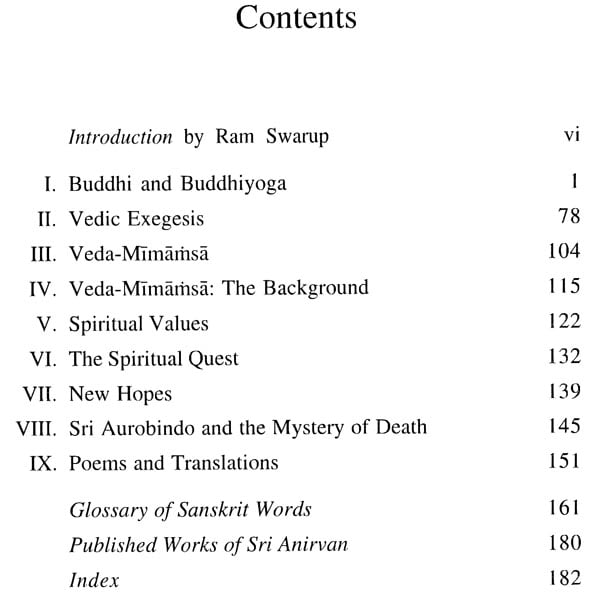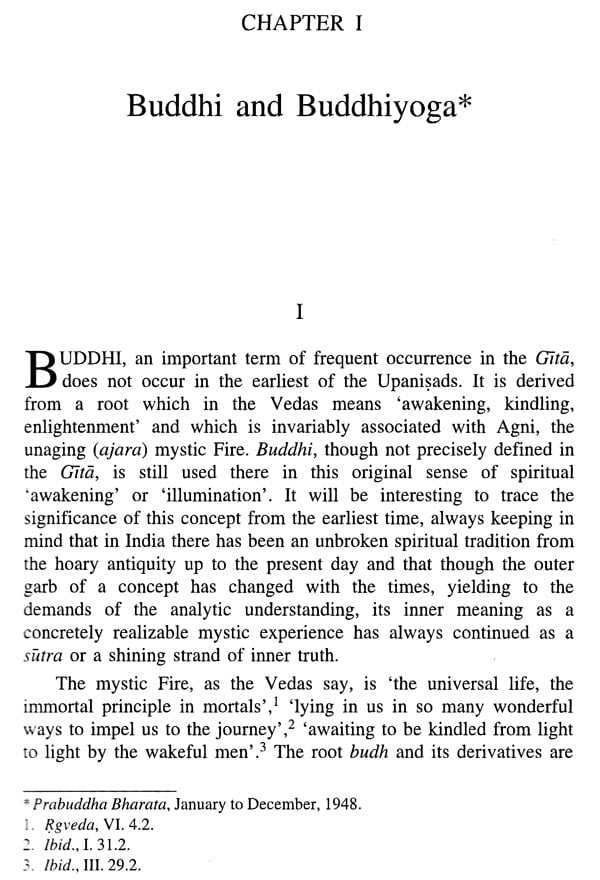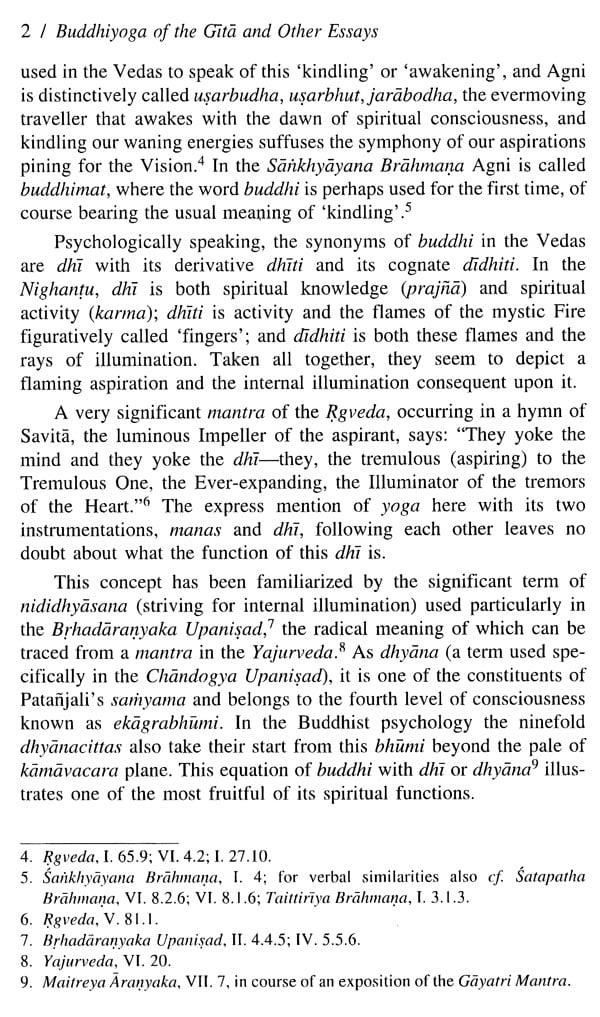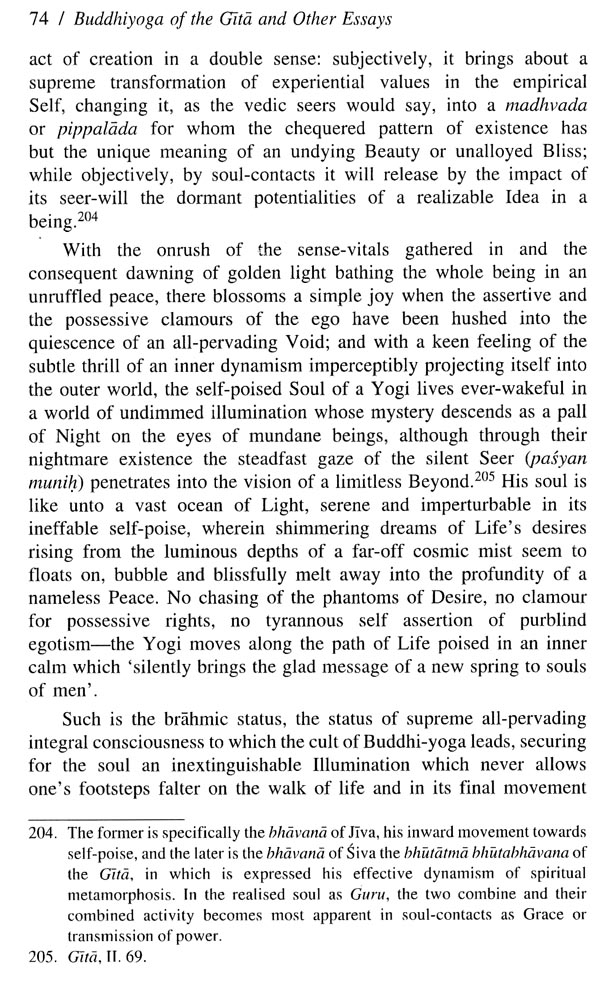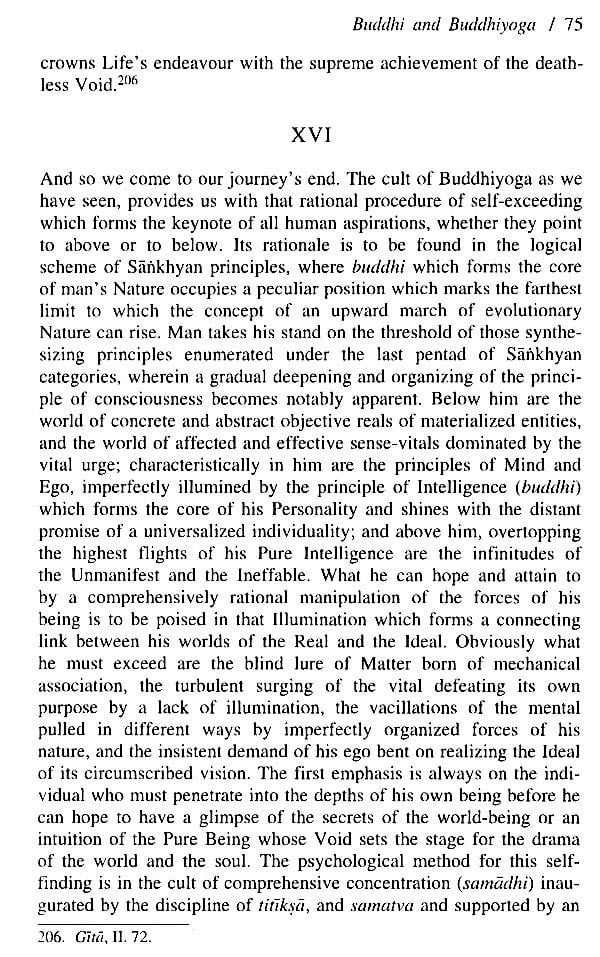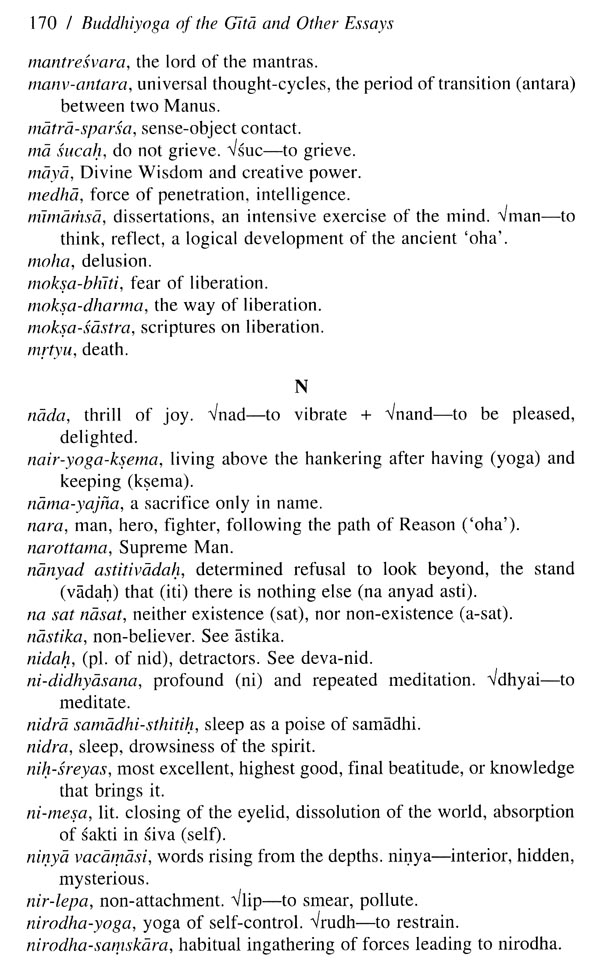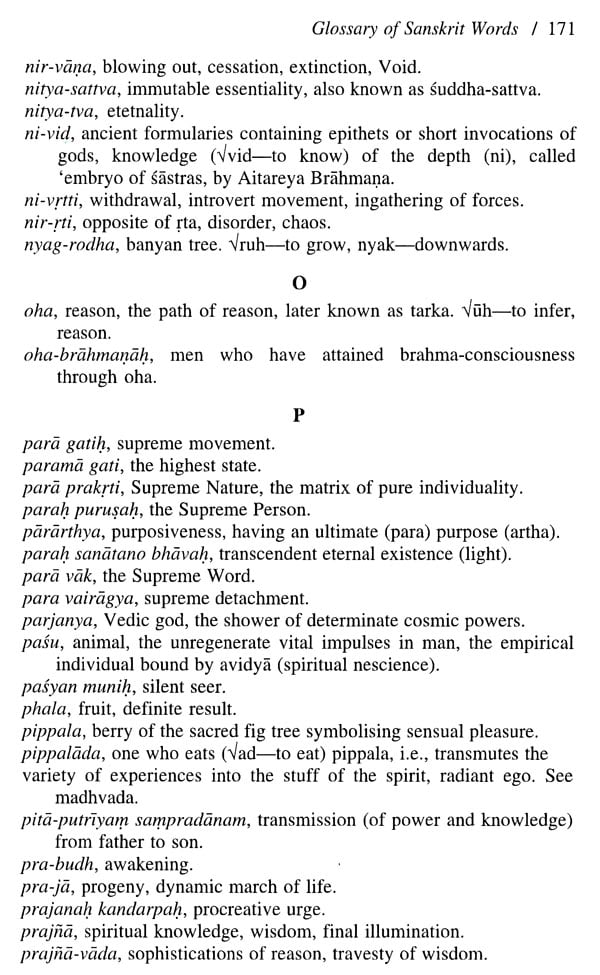
Buddhiyoga of The Gita and Other Essays
Book Specification
| Item Code: | NAR630 |
| Author: | Shri Anirvan |
| Publisher: | Akshaya Prakashan |
| Language: | English |
| Edition: | 2018 |
| ISBN: | 9788188643639 |
| Pages: | 204 |
| Cover: | HARDCOVER |
| Other Details | 9.00 X 6.00 inch |
| Weight | 420 gm |
Book Description
Sri Anirvan wrote almost exclusively in Bengali and only occasionally in English. This is a collection of all his English writings except his letters which he wrote to his Western and non-Bengali friends and disciples. The present volume contains nine essays, the first on Buddhiyoga being the most considerable. In these essays, Sri Anirvan covers a wide area and touches upon most of the salient points of Hindu spirituality, directly and indirectly. He roams through the vast territory of Hindu philosophical and theosophical thought with ease and familiarity. He combines scholarship with sa dhana supported by an intellect which is analytic as well as synthetic. Beginning with the Rgveda, Sri Anirvan shows how for every Vedic concept or image there is a Puranic or Tantric equivalent, how the same truths are found in Buddhism, and how they are celebrated by medieval saints. He shows inner links in the truths of different spiritual traditions and sadhanas and relates them to the deeper life of the soul. India would rise through the rise of the great Hindu culture and the soul of Hinduism is the life of the spirit. Sri Anirvan has shown the unity and profundity of this culture and, to that extent, has become a leader of the Hindu renaissance. He has shown the catholicity and universality of this culture and how this culture alone can be the true religion of a future, awakened humanity. According to him, 'science, logic, democracy are all tending towards the spiritual, democratic movement', and when 'men has learned to be spiritually free from all dogmas ... then the Vedic spirit will draw upon him making the heaven and the earth one.'
Shri Anirvan was born on July 8, 1896 in the town of Mymensingh (now in Bangladesh). At the age of eleven he knew the AstadhyayT of Panini by heart and daily recited a chapter from the GTO. He went for his college studies to Dhaka and later on to Calcutta. After completing his studies, Sri Anirvan took sanyasa and became Nirvanananda Saraswati. But a few years later he dropped the ochre robes and changed his name to Anirvan, by which name he became known to the world at large.
His first book was a Bengali translation of Sri Aurobindo's The Life Divine which was published in 2 vols. during 1948-51. But the centre of his studies was the Vedas on which subject he acquired a rare mastery over the years. His great work, Veda Mimamsa, was published in 3 vols. in 1961, 1965 and 1970. Meanwhile, several other works on the Upanisads, the GTO, Vedanta and Yoga had also been published and translated into Hindi and English.
Shri Anirvan was born on July 8, 1896, in a small town, Mymensingh, now in Bangladesh. Most houses there had thatched roofs, palm, mango and banana trees; beyond, skirting the town, were sprawling rice-fields; nearby, flowed the mighty Brahmaputra. Thus from his infancy, the child imbibed love of nature which lasted throughout his life. Shri Anirvan had almost a botanist's knowledge of flowers, plants and trees.
The parents belonged to a Bengali, Kayastha family. The father, Raj Chandra Dhar, practised medicine; the mother's name was Sushila Devi. Both were affectionate and pious. Thus the child grew in an environment of love, harmony and wholesomeness.
At the age of eleven, the boy knew Pariini by heart and daily recited a chapter from the Gita. Except for the precocity of the boy, there was nothing unusual in this-it was part of the traditional teaching at home for most boys of his age and caste. There was also a school, part of the newly-established system of education introduced by the British Government in India. Here too, the boy did very well and excelled fellow students.
Even at an early age, Shri Anirvan had a markedly spiritual bent of mind. He was different from the boys of his age. He loved solitude; and even while he was in the company of his playmates, he had his own `problems' and thoughts. One night, when he was only nine, he had a spiritual experience: the sky with its myriad stars entered into him. He fell into a swoon. This experience persisted throughout his life, and Sri Anirvan became a sadhaka of the Void, of freedom, of detachment, all symbolized by the sky.
Even earlier, on another occasion, when he was only seven, he saw a small girl of great beauty. Was it a real object or a spiritual vision? Whatever it was, it must have had a deeper source, for it lived with him throughout his life as a symbol of higher things, as a mystery waiting to be solved, as a benign influence entering into various phases of his sadhana, a force drawing him onwards and upwards, a presiding deity of his life. 'Her grace was the light of my life for many years,' Shri Anirvan told his biographer, Madame Lizelle Reymond. Later on in his life, he recognized in this vision `the Divine Mother, born of perfect wisdom', the Uma Haimavati of the Kenopanisad, Prajna or Atman of the Hindu scriptures.
In the same vein, one day a thought came to him with the force and suddenness of a spiritual realization, that he was free, free from the restrictions of castes and creeds, free in the soul, 'free like Faqir Chand', a wandering, Baul minstrel. All these experiences became part of the fabric of his soul as he grew in age and contemplated on these mysteries.
Shri Anirvan was also destined to meet his Guru, Swami Nigamananda, quite early in his life. He first heard about him from his father; and even before he met him, he accepted him his Guru, seized with the idea of loving him and serving him, and following him as a sanyasin. It does not normally happen this way, but behind this resolve must have been the saMskdras of past lives.
One night, when he was sixteen, he left his home to join his Guru also the Guru of his parents. Meanwhile, he had earned a state scholarship. So the Guru sent him back for further studies saying that he would need a scholar like him later on. So for six years, Shri Anirvan was away first in Dhaka and then in Calcutta for higher studies, going to the Ashram of his Guru only during the vacations. Here his academic career was always brilliant; and he secured record marks.
After his studies were over, he went back to his Guru and served him for twelve long years. The Guru's Ashram, called Assam-Bangiya Saraswata Math, was at Kokilamukh near Jorhat in Assam. It was not an Ashram in the traditional sense of the term. There were no instructions in Yoga or religion. It was all work for the Guru. It was inspired by Swami Vivekananda's call to active life of labour and service by young men living as brahmacharis and monks. Shisyas here worked on a swampy land, draining it, reclaiming it, cultivating it, digging wells, ditches and channels, cutting down trees, building houses. Shri Anirvan also did his share of the digging, ploughing and woodcutting. After initial labour, the Ashram prospered. The number of inmates increased from four or five in the beginning to fifty in the end. They were growing their own food. They had now also a school, a dispensary, and a monthly journal. Shri Anirvan taught in this school, Rishi Vidya-laya, Sanskrit, philosophy and Sahkhya, and became its Principal; he also edited the Ashram Journal, Aryadarpana. Among the inmates Shri Anirvan taught, he remembered one in particular with admiration in later life. He was Jugal Kishore who had been a coolie (a disguised name for a slave) on a British tea plantation and who even in the Ashram did the most arduous work. He was a poor scholar of Sankhya and very inarticulate, but he "experienced all the Samadhis of the Sankhya."
From a brahmachari, Shri Anirvan was initiated into full-fledged sanyasa with a new name, Nirvanananda Sarsawati. But new forces were gathering inside him. His soul was seeking release from the cares of the Ashram life which, as it developed, involved many administrative and other mundane activities. While the Guru wanted him to become the head of the new colony, Shri Anirvan had his own daimon. His soul sought freedom to express itself in its own way. One day in 1930, he left the Ashram. And events proved that he was right. It was a great gain for the cause of Indian religious culture of which he became a great interpreter and exponent. He was now on his own. In due course, he also gave up the saffron clothes of a sanyasin. He also changed his name from Nirvariananda to Anirvan, a name by which he was later on known to the larger world. It signified a change of emphasis in approach, philosophy and life-goal. It was also a declaration that he was no longer bound by the vows of sanyasa and that he was free from the ties which even sanyasa forges.
